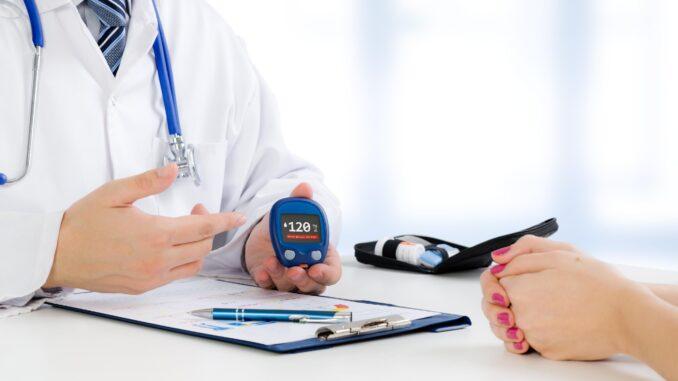
Last Updated on by lizzy
Diabetes is a chronic medical condition characterized by high blood glucose levels. It affects millions of people worldwide and has a significant impact on both individuals and society as a whole

Types of Diabetes
There are three main types :
Type 1 diabetes
It occurs when the body’s immune system mistakenly attacks and destroys the insulin-producing cells in the pancreas. It usually develops in childhood or adolescence and requires insulin therapy for life.
Type 2 diabetes
It is more common and is characterized by insulin resistance, where the body’s cells do not effectively use insulin.
Gestational diabetes
Occurs during pregnancy and usually resolves after childbirth.
Causes and Risk Factors Of Diabetes
Type 1 Diabetes
Autoimmune response: In type 1 diabetes, the immune system mistakenly attacks and destroys the insulin-producing cells in the pancreas, leading to a deficiency of insulin.
Genetic predisposition: Certain genes increase the risk of developing type 1 diabetes, although having these genes doesn’t necessarily mean an individual will develop the condition.
Type 2 Diabetes
Obesity and overweight: Excess body weight, particularly around the abdomen, is strongly linked to the development of type 2 diabetes.
Lifestyle factors: Sedentary lifestyle, lack of physical activity, and poor dietary habits, including high consumption of sugary and processed foods, can increase the risk of type 2 diabetes.
Insulin resistance: Over time, the body’s cells may become resistant to the effects of insulin, leading to elevated blood sugar levels.
Family history: Having a close family member with type 2 diabetes increases the risk of developing the condition.
Ethnicity: People of certain ethnic backgrounds, such as African, Hispanic, Asian, or Native American descent, have a higher risk of type 2 diabetes.
Gestational Diabetes
Pregnancy: Hormonal changes during pregnancy can lead to insulin resistance, which may result in gestational diabetes.
Family or personal history: A history of gestational diabetes in previous pregnancies or a family history of type 2 diabetes increases the risk.
Obesity: Being overweight or obese prior to pregnancy raises the risk of developing gestational diabetes.
Other risk factors
Age: The risk of type 2 diabetes increases with age, especially after 45 years.
High blood pressure: Hypertension is associated with an increased risk of developing type 2 diabetes.
High cholesterol levels: Abnormal lipid levels, including high triglycerides and low HDL cholesterol, can contribute to the risk.
Polycystic ovary syndrome (PCOS): Women with PCOS have an increased risk of developing type 2 diabetes.
Certain medications: Some medications, such as corticosteroids, antipsychotics, and certain antiretroviral drugs, may increase the risk of developing the condition.
Symptoms of Diabetes
Frequent urination (polyuria): When blood sugar levels are high, the kidneys try to remove the excess sugar by excreting it through urine, leading to increased urination.
Excessive thirst (polydipsia): Increased urination can lead to dehydration, causing a person with diabetes to feel constantly thirsty and drink more fluids than usual.
Intense hunger (polyphagia): This occurs because the body is unable to effectively use glucose for energy due to insufficient insulin or insulin resistance.
Unexplained weight loss: People with type 1 diabetes may experience rapid and unexplained weight loss.
Fatigue: F High blood sugar levels can interfere with the body’s ability to obtain energy from glucose, leading to fatigue.
Blurred vision: Elevated blood sugar levels can cause changes in the shape of the lens in the eye, resulting in blurry vision.
Slow healing of wounds: Sores, cuts, or infections may take longer to heal and be more prone to complications.
Frequent infections: High blood sugar levels can weaken the immune system, making individuals with diabetes more susceptible to infections.
Tingling or numbness: Prolonged high blood sugar levels can damage nerves, leading to a condition called diabetic neuropathy.
Diagnosis and Screening of Diabetes
It involves various tests and assessments to determine whether an individual has the condition. Here are some common methods used for the diagnosis and screening :
Fasting Plasma Glucose (FPG) Test: This test measures the fasting blood sugar level after an individual has not eaten for at least 8 hours. A blood sample is taken, and if the fasting plasma glucose level is 126 milligrams per deciliter (mg/dL) or higher on two separate occasions, it indicates diabetes.
Oral Glucose Tolerance Test (OGTT): Initially, a fasting blood sugar level is measured, followed by consuming a glucose-rich beverage. Blood sugar levels are then checked at regular intervals over the next two hours. If the blood sugar level is 200 mg/dL or higher after two hours, it indicates diabetes.
Glycated Hemoglobin (A1C) Test: This blood test measures the average blood sugar level over the past two to three months. It provides an indication of long-term blood sugar control. An A1C level of 6.5% or higher on two separate tests is considered diagnostic.
Random Plasma Glucose Test: It involves checking blood sugar levels at any time of the day, regardless of when the person last ate. If the blood sugar level is 200 mg/dL or higher and the individual exhibits symptoms, it indicates the presence of the condition.
Screening for Gestational Diabetes: Pregnant women are often screened for gestational diabetes between 24 and 28 weeks of pregnancy.
Complications of Diabetes
Cardiovascular Complications
- Heart disease: People with this condition have an increased risk of developing heart disease, including coronary artery disease, heart attack, and stroke.
- High blood pressure: Can contribute to the development of hypertension, increasing the risk of heart disease and stroke.
- Peripheral artery disease (PAD): It can cause narrowing and hardening of the blood vessels in the legs and feet, leading to reduced blood circulation and potential complications, such as ulcers and infections.
Nerve Damage (Neuropathy)
- Peripheral neuropathy: High blood sugar levels can damage the small blood vessels and nerves, leading to numbness, tingling, or pain in the hands and feet. It can also affect other body parts and organs.
- Autonomic neuropathy: It can damage nerves that control involuntary bodily functions, leading to problems with digestion, bladder control, sexual function, and blood pressure regulation.
Kidney Disease (Nephropathy)
Diabetic nephropathy
Prolonged high blood sugar levels can damage the kidneys’ filtering units (glomeruli), leading to impaired kidney function, protein leakage in urine (proteinuria), and eventually, chronic kidney disease.
Eye Complications (Retinopathy)
- Diabetic retinopathy: High blood sugar levels can damage the blood vessels in the retina, leading to vision problems, including blurred vision, floaters, and even blindness if left untreated.
- Cataracts and glaucoma: People with the condition have a higher risk of developing cataracts (clouding of the lens) and glaucoma (increased pressure in the eye), further affecting vision.
Foot Complications
- Diabetic foot ulcers: Nerve damage and poor blood circulation can lead to foot complications. Minor cuts or injuries can develop into ulcers and, if untreated, may lead to infection and even amputation.
- Peripheral vascular disease: Reduced blood flow to the feet and legs can lead to slow wound healing and an increased risk of infections.
Skin Complications
Bacterial and fungal infections: High blood sugar levels and compromised immune function can increase the risk of skin infections.
Mental Health Disorders
- Depression is associated with a higher risk of depression, which can affect overall well-being and quality of life.
- Distress: The stress and emotional burden as a result of managing the condition.
Treatment and Management of Diabetes
Lifestyle Modifications
- Healthy diet
- Regular physical activity
- Weight management
- Stress management
Monitoring Blood Sugar Levels
- Regular self-monitoring of blood sugar levels using a glucose meter
- Continuous glucose monitoring (CGM) systems may be used, which provide real-time glucose readings and alerts for better management.
Medication
- Insulin
- Oral medications
Education and Self-Care
- Education: Learning about its management, and complications is crucial.
- Self-care practices are important self-care practices for management.
Regular Medical Check-ups






Leave a Reply